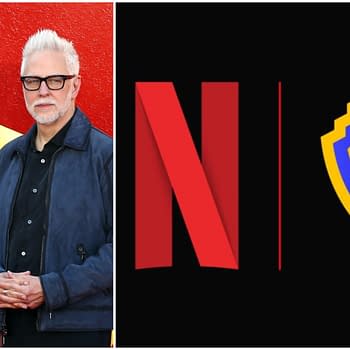Posted in: Comics, Recent Updates | Tagged: Alex Siegel, C.O.W.L., c2e2, Comics, entertainment, image comics, kyle higgins, Rod Reis
Image Watch: C.O.W.L. – Talking With Kyle Higgins And Alec Siegel Plus Big Art Reveal
By David Dissanayake
This May sees the release of Kyle Higgins, Alec Siegel, and Rod Reis' new Image series, C.O.W.L. This is one of the new Image titles that I've been excited about since it was first announced earlier this year at Image Expo. Many of you may know Higgins from DC's Nightwing book, which was one of the most consistently underrated books of the New 52. This is the trio's first creator owned series, and Reis' first book as solo artist (though before he's been a colorist on a bunch of awesome books you've probably read).
This is a STELLAR debut for Reis. Just look at these interior pages:
C.O.W.L. is a story set in 1960's Chicago that's in the midst of major societal change. Superheroes helped win World War II, coming back to help overthrow mafia control of the city, but what happens now that the war is won and all the great supervillains are defeated? What does a labor union of superheroes do to maintain relevancy? Here is the solicit for issue #1:
"Welcome to the "Chicago Organized Workers League"— the world's first Super-Hero Labor Union! While C.O.W.L. once stood as a beacon of hope against an epidemic of organized crime and an unbeatable "brotherhood" of Super-Villains, the union now faces its fiercest foe yet—a disillusioned public. In targeting the last of the great villains, C.O.W.L. attempts to prove its value to the world and to each other, while staving off villainy from both outside and inside its offices."
I had a great talk with Kyle and Alec about all things C.O.W.L. and after seeing the EXCLUSIVE ART they've given us, I'm even more excited about this book than I already was.
David Dissanayake: So, C.O.W.L. is a superhero labor union story set in post war Chicago during the 60's. Tell us a little bit about that idea. I know this originally started off as The League a video project between you two back in college, but I'm curious, what was it about this time period and bringing superheroes into it that really interested you?
Kyle Higgins: Well, I had the idea of an organized group of superheroes when I was transferring to Chapman University for Film School.. There was something about a labor union of heroes that kind of made me laugh, and as I started working on it as a writing sample, it started heading in a more serious direction. Ultimately, it turned into my Thesis film. The 1960's angle was actually the thing that did it for me, too. To really look at the moral and ethical questions something like that would create is what– for me– is most interesting about the world and the idea.
Chicago's political history is fascinating in its own right, and then when you tack on labor unions of the 60's, the cold war, and the rise of the flawed Marvel Comics characters, it all kind of gives a gravitas to the idea that I don't think would be there if we were setting it modern day.
Alec Siegel: Yeah I agree with that. It's also that "one step removed" from the world we live in that allows us to explore political and ethical situations without hitting people in the face with them.
You mentioned a little bit the 60's being a time of change, and looking at the idea of a superhero labor union as being grounded, it works to do it in the 60's because it was already an era of such great change for the country. Then when you put the superheroes in it, you can start to see how they are effecting change and how the times are changing around them.
KH: Yeah, and at its core it's really about exploring the corruption of the American institution in the early 60's. In the book, this organization of heroes has been around since 1949, and now we're thirteen years later when the first issue picks up and they're taking down the last of the Chicago Six– the last of the great villains. It really is the end of an era. You see that a lot– a lot of larger companies and bureaucracies where at a certain point, the allure and focus on survival starts to clash with the purpose they originally started with. That's one of the other motifs we're really looking at with C.O.W.L.
DD: Can you talk a little about the research that you did for this. Obviously there is a big historical divergence, but is this book set against real historical events of Chicago and unions in the 60's?
KH: Yeah, when applicable. I don't think either of us want to go down the path of putting another shooter on the grassy knoll. You don't want to do something just to be cute about it. Where applicable and where we deem tasteful to converge with actual history, we will. What's most important is whether it works for our story. This version of the 60's is more in line with a kind of James Bond or The Incredibles version of the 60's, where it's slightly more stylized. The technology is a little further advanced than the 60's that actually happened.
Any time that you introduce a divergence like superheroes, it's natural to think "well, what other things would have changed as a result?" What would the comic book industry have been like if there were actually superheroes, or at least costumed fighters, running around in that era?
DD: Are issues of labor something that will be a focus in the book? I'm curious as to how in depth the political issues of that will be touched on?
KH: Yeah there are issues of labor touched on, but through the lens of the superhero industry. So, basically when the first issue opens they're in the process of negotiating their next contract with the city of Chicago. There are certain points of contention in the deal, there are certain things that C.O.W.L. as an organization wants for its members, and there are certain things that the city is requesting. So, we touch on some of that, definitely. It's a part of the world building.
AS: A big part of the question, going all the way back to writing the short film, is what makes a hero a hero? Once a paycheck is involved, does that change the nature of the "hero" work? It's a back and forth that we're exploring from several viewpoints.
KH: I would also say that the relationship between C.O.W.L. and other unions is something we're touching on a little bit. When a fight or a battle happens – as you'll see in the first issue – there are repercussions for that. If people lose their lives or there is any kind of destruction, at its most basic level, it affects jobs in the construction industry and it affects city hall and politics. There are a lot of elements that go around something like C.O.W.L.
DD: Let's talk a little bit about the structure of the book. This is an ongoing series, but I'm curious as to your approach. Will it be big five or six issue arcs mostly, or will there be smaller single or double issue vignettes about this larger word? How are you two approaching this?
KH: It's an ensemble book and right now the structure is five issue arcs. The cast is made up from the different divisions of C.O.W.L. We've got the leadership, which is Geoffrey Warner – formerly the Grey Raven – who is something of a living legend and the last of the golden age heroes. He's the founder of C.O.W.L. who hung up his suit years ago and now runs C.O.W.L. as its union chief.
Then we have the tactical division which is Arclight, Radia, Blaze, and Recon. There's the investigations division, where our point of view character is a gentleman named John Pierce. Then we have the patrols division where the point of view characters are two partners – Eclipse and Grant Marlow.
As far as the structure goes, we're bouncing between these characters and their stories. They all intertwine and build to a big moment towards the end of issue four. From issue to issue, the A-plot shifts based on who the focus of the issue is. There's a bigger story at play, but these guys are really our driving force. The book is first and foremost a character piece.
DD: Talk a little about working with Rod Reis. His pages look phenomenal.
KH: Oh, Rod is amazing. We are incredibly fortunate and lucky to be working with him. I met Rod on Nightwing, actually. Our first sixteen issues of Nightwing, Rod colored. Rod and I became friends pretty quick, as I tend to get very involved in coloring. To me, coloring is a very underrated part of the comic book making process and anyone who makes comics knows how important it is. I come from a filmmaking background, so colors are the mood, the atmosphere, the lighting, and it can really set the tone and feel of a scene or a book.
Rod and I developed really good chemistry on Nightwing, going back and forth with Eddy Barrows. Then, about two years ago, I started to notice Rod doing commissions at New York Comic Con. He was doing these full watercolor pieces, and he did a Nightwing headshot for me that was really cool. It was in his own style, which reminds me a lot of Bill Sienkiewicz. I asked him if he had ever thought of doing his own book, but he said "ah, I don't know. I know my coloring is pretty good, but I don't know if my art is really there." The next year I saw him doing sequentials in watercolor and gouache for a little side project of his called The Curious Astronaut. They were really, really cool.
So, a few months later, it just so happened that my friend Brian Buccellato was doing an anthology book for his creator-owned series Foster and I wrote an eight page story. It was this really dark, noir, Taxi Driver influenced piece that I asked Rod to illustrate. He agreed, and did these fantastic painted/digital combination pages. I called Alec and asked him about finally pursuing something with The League. I had been writing comics for a few years, writing for DC, that I thought we might be able to get it going and Rod would be an interesting out-of-the-box choice for the art.
AS: Yeah, we have a painting on our wall of a Havok commission that Rod did. I hadn't seen The Curious Astronaut pages at that point, but just looking at that Havok painting, I knew this was the guy. Absolutely. I was sold.
KH: Then at the C2E2 last year he showed me pages from what would become C.O.W.L. that are just gorgeous. Full watercolor pages. Its been a fantastic experience. We're all friends. This is Rod's first book and it's our first creator owned book. It's really just a very nice dynamic and we're very lucky that its worked out the way it has.
DD: Yeah, just seeing those preview pages you can see how phenomenal he is. He's just killing it on this book. Now, I'm curious about the working style on this book. Are you two writing a full script for Rod or is it more Marvel style open script to give him leeway with the story telling?
KH: It's a combination. It's a full script but it's also a full script with the understanding that we want Rod to be Rod and we want him to bring his own vision to the pages.
I've worked Marvel style quite a bit at DC, actually, so when need be… I'm very comfortable scripting after the art is done. Even with full script, we go back and rework things to make it fit the art.
As far as the actual writing, Alec and I have been writing together for so long that it's not out of the ordinary for us to actually work with one of us talking and the other typing, or literally both of us going line by line on the same thing. I know a lot of co-writers can't be in the same room together, a lot of our friends who co-write don't actually write together, but we're able to do both.
AS: Well, to be fair, when we start a script we break the whole thing together… but then he'll pick a scene and I'll pick a scene and we'll trade on and off. As it gets closer to being finished, then it gets like Kyle said where one of us is at the computer and the other one is bouncing a tennis ball off the wall while we go line by line.
KH: We haven't killed each other yet!
DD: So how long do you think C.O.W.L. will run for? Sales permitting, obviously, do you see this as a big 60-75 issue series or something smaller?
KH: I would love that, yeah! We have talked about where this goes, where it could go, and the ending. It's not an ending we want to hit any time soon [laughs]. I'll put it that way. It is a world that lends itself to evolution and change, so I can very easily see this, sales permitting, continuing to grow and evolve. Nothing would make me happier, and those are my favorite types of stories, where you can follow characters for long periods of time and watch them grow and change. The same thing with the writers.
I went through this on Nightwing to a smaller extent. I wrote that book for three years and who I was when I started it and who I was when I finished it was very different. I think that's reflected in the characters and in the stories. It's a snapshot of the writer's life. We'll see how this goes. Fingers crossed that people dig it, dig the first issue, and stick around for the ride.
I will say this: they will be entertained.
DD: Alright, well one final question: What are you two reading, these days?
KH: I'm reading a lot of Image stuff, actually. Not to sound biased or anything [laughs]. East of West, Black Science, Pretty Deadly, Velvet, Manifest Destiny, Deadly Class. I follow writers. I've also been reading Mark Waid's Daredevil which is amazing and one of my favorite superhero comics that's out right now. I also just read the first issue of Southern Bastards actually, and that's a tour de force. That thing is going to be awesome. I can't wait to see where the two Jasons take it.
AS: I also have been following Velvet. It's been tough because I also work a 9-5 job so when I'm not there it's the time to focus on C.O.W.L. and some other not-yet-announced projects. I'm behind a little bit, but I've been following Velvet and East of West. I also just started reading Feast For Crows, now that Game of Thrones is on, so I can keep ahead of the series.
Let your local retailer know to pick up an extra copy of C.O.W.L. for you. It's going to be a great ride.
Order C.O.W.L. #1 with Diamond Code: MAR140477
David Dissanayake is a Senior San Diego Correspondent at Bleeding Cool. Give him a shout on Twitter @dwdissanayake or come say hello to him at Mission: Comics & Art in San Francisco.






















